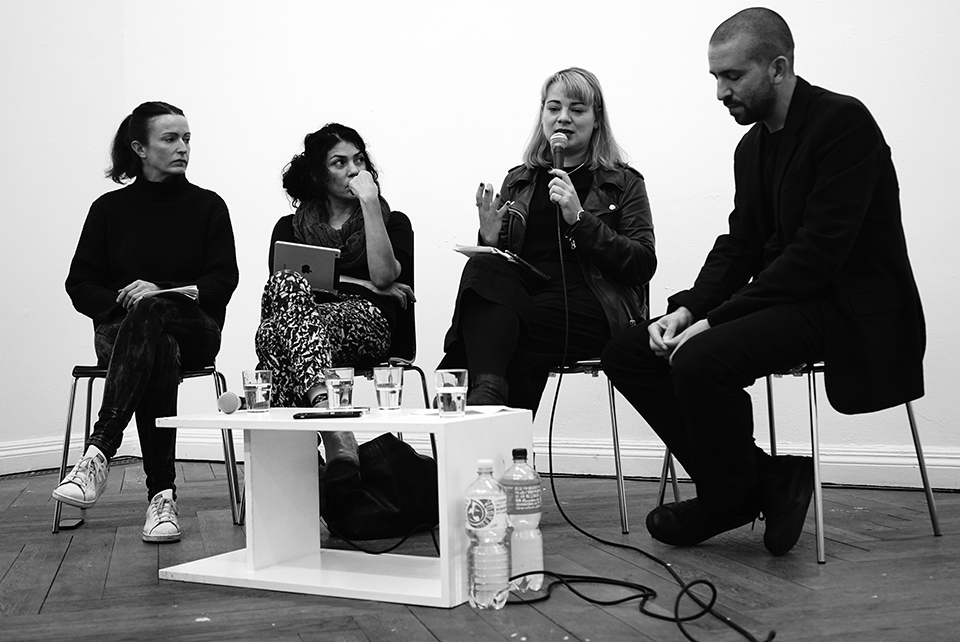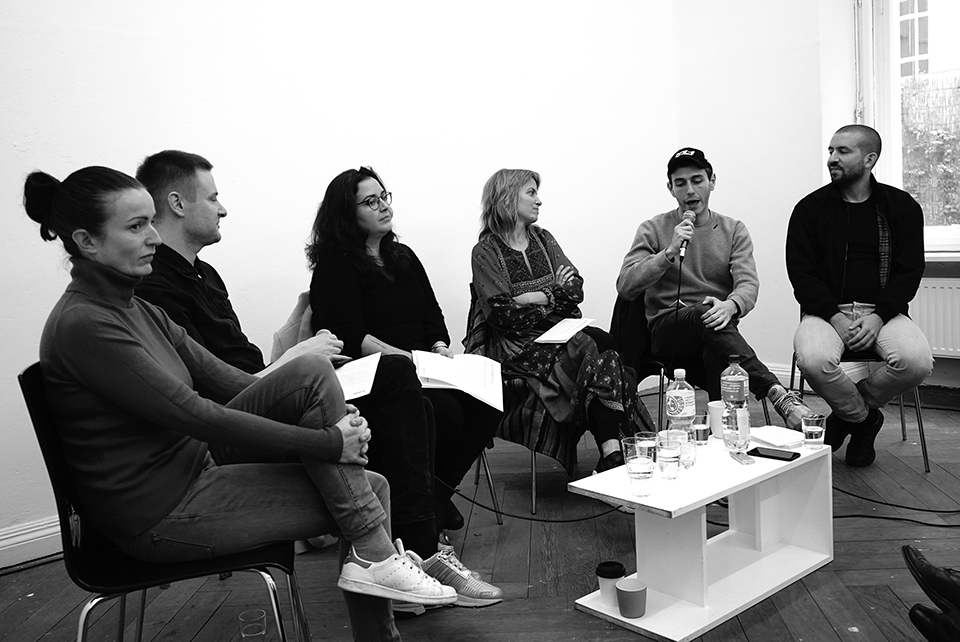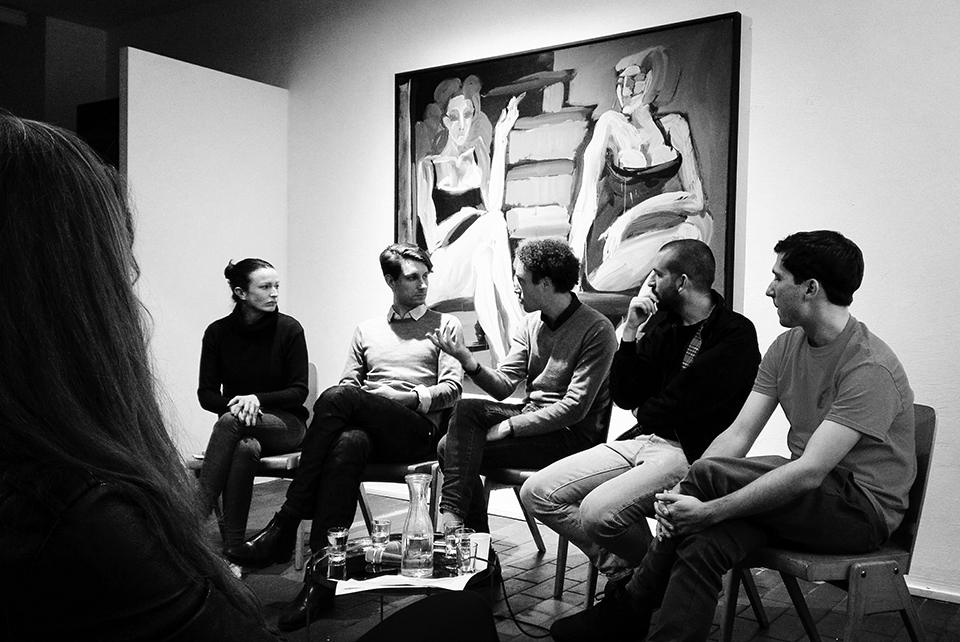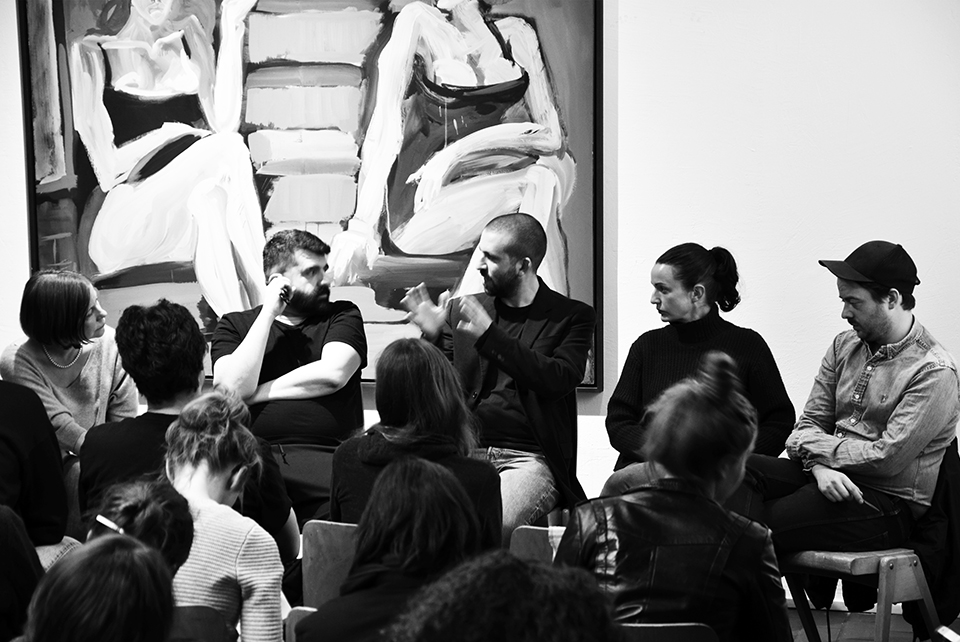THE CRITICAL CONDITION
between assholism and uncriticality
Discussion I
The Tyranny of Two: The Market and the Dead Male Philosopher Appreciation Society
with Juileta Aranda and Jeni Fulton
EIGEN + ART Lab
October 16, 2017
Discussion II
At the Foot of the Olympus: Crowds of Pleasers and Powerlessness
with Simon Denny, Daniel Keller, Laurie Rojas and Julia Voss
EIGEN + ART Lab
October 16, 2017
Discussion III
The Crux of Quality Among Feverish Dreams of Acceleration and Lots of Clutter
with Krist Gruijthuijsen, Amadeo Kraupa-Tuskany and James Whipple (M.E.S.H.)
ST. AGNES/KÖNIG GALERIE
October 31, 2017
Discussion IV
Leaving the Valley of the Shadows: Critique of Aesthetics / Aesthetics of Critique
with Mareike Dittmer, Dan Rees and Mohammad Salemy
ST. AGNES/KÖNIG GALERIE
November 1, 2017
The term ”asshole” carries two meanings: it can stand for an individual thought of as stupid and worthless, or for an annoying, contemptible one. It therefore mirrors the two mainstream understandings of the figure of the critic: on the one hand someone expressing, for obscure reasons, an unfavourable opinion, which hasn’t previously been agreed upon or tweeted about by a sufficient number of celebrities. On the other, a stick-in-the-mud, stick-up-the-ass kind of person, expressing judgement on the basis of quality, merit or other dusty criteria. To the eyes of most, the first one must appear as a fool, the second one as an arrogant prick. What ultimately turns them into outcasts, however, is their apparent, unapologetic uncoolness. Once the People’s Jury has spoken, the only options are either an act of contrition or else oblivion for the time being. In times of globalised puritanism and digitalised self-optimisation, that illusion of democracy that is direct democracy has fuelled the militancy for a standardising revolution. But the discordant element is not only shunned for its disturbance of this harmonising co-optation—which is, in the end, just a reverberation of a business mentality that has percolated to the lowest strata of our thoughts and actions: so far away seem the times of true intellectual resistance, that the critical voice has almost ceased to be comprehensible and it looks like its motivations can now only be read as suspicious and extraneous.
The Tyranny of Two: The Market and the Dead Male Philosopher Appreciation Society
In the sphere of art, where one expects complexity and contrarieties to prosper, the fragile endeavour of critique had, over time, to give way to a selective ferocity exerted by two opposed entities: on the one hand an art market spinning out of control, where commercial—or potentially commercial—success is becoming the only gauge by which relevance is measured, and which precisely because of this focus on fame and monetisation tends to promote the mediocre; on the other hand, a cartel of influential theory clubs, whose members belong to those fields of study devoted to post-postmodern self-castrating nihilism or to a Marxist messianism with an overbearing prophet and no saviour in sight—or to both of them at once—and who expect total conformity from their protégés.
The contraposition between these two poles is rather fictitious. The Marxist would say: What do you expect, there is no outside to capitalism within capitalism! But leftist propaganda (as well as cool disruptive neo-poststructuralist fury) always sells beautifully anyway, thanks to its non- conciliatory opposition to everything else, which is what ultimately makes the sexiness of extremism. The market and the Dead Male Philosopher Appreciation Society just party too well together, sharing a similar ruthlessness and even thuggishness, and a sense of entitlement they both derive from the privileges of their fringe existence, which protects them from being scrutinised too closely.
Under these circumstances, the last remnants of critical thinking are mainly confined to cryptic press releases or benevolent reviews, while those ambitious enough will most likely conform to a certain strand of trendy academic dogmatism—clawing their way up from there—rather than take a moment to think. If working in sales or producing small formats framed in vibrant RAL colours for the next art fair seems alienating and deadening to you, try having a discussion with some of these bloodthirsty leftie careerists.
Now, the question that should be raised here is what to do of all this when one is neither inclined to ”sell out” nor to buy into it. This is not to suggest that we should be looking for another lame and boring alternative to the market, because the market in itself is not the ultimate problem. What is needed is the emergence and visualisation of alternatives to the current alternatives. There is no lack of deeply critical perspectives, which are at the same time not too enamoured of themselves, but they are, however, scarcely influential, they haven’t penetrated key institutions yet and, even if—or maybe precisely because—they lack their elitist contempt, they are much less easily marketable than the dominant theories du jour.
At the Foot of the Olympus: Crowds of Pleasers and Powerlessness
It used to be that if you told your parents that you wanted to study art and ditch law school, you would be threatened with disownment. But now that ”creative” is a job description, studying art seems like a rather good investment and schools have started to churn out so-called professional artists en masse. With art becoming omnipresent, however, taking it too seriously feels more and more embarrassingly outdated, while its popularisation and professionalisation leads to an ever-growing competitiveness among peers, that causes the focus to shift almost entirely to art as career. Hordes of young would-be artists are subject to the pressure to succeed, to put together their Pinterest-feed-like conglomerate of aesthetics and references and push push push, from Facebook event to Facebook event, travelling and ”connecting” worldwide courtesy of daddy’s money. They must please not only middle management art professionals with short attention spans, but also their anxious parents and their many thousands of networking ”friends”/competitors.
The outcome of all this is not something one could gently dismiss with a breathy ”Aww” and a little stab of nostalgia for one’s own youthful outpourings, not only because it tends to be so polished, savvy and calculated, but also and especially because we see this stuff all the time, hanging and standing around in hot new galleries who are on the constant lookout for ever- younger shooting stars. The similarities with twenty-somethings getting their pop star careers pushed by record labels are striking, although singing ”He’s the reason for the teardrops on my guitar” with rhinestones glued to the side of one’s face doesn’t require a grasp of history and some rudiments of aesthetics, while visual artists will need far more than that to last longer than a hit on Spotify.
If one then looks closer at the real motivations and urgencies behind much of what gets produced and sold as art today, it would appear to rather fit the definition of ”applied art”—and not necessarily due to the current over-presence of conceptual pottery in hipster galleries, but in a rather functional sense of the term. A tiffany lamp is an object made mainly to look (arguably) good on the mantelpiece and, on top of that, to shed light. Analogously, many of the art artefacts produced today seem to serve the sole purpose of pleasing, while functioning as placeholders for their maker’s spot in art.
The crucial point here is—like the sweet porridge from the Grimm Brothers’ fairy tale—that the crowds of pleasers are so compulsively over-present, over-productive and attention-grabbing that everything else risks getting lost in the shuffle. Nobody, not even Hans Ulrich Obrist on sleep deprivation can sustain the amount of work necessary for sorting the wheat from the chaff without falling back on a relentlessly thorough pre-selection. And that task, as mentioned before, is taken care of by the lobbyists of the intelligentsia and by salespeople and intermediaries, who do not necessarily do a lousy job, but whose criteria are governed solely by ideology or personal interest. Critique is completely absent here as it is at the foot of the Olympus, among the angst- ridden masses of busy bees. And no matter how hard we strive for intellectual independence from this misery, we are all dependent on the opinions of others. But what when all the wells are poisoned?
The Crux of Quality Among Feverish Dreams of Acceleration and Lots of Clutter
It seems far less arduous to discuss the moral categories of good and bad today than to talk about definitions of good and bad quality. All around us, the spreading out of heaps of standardised crap is causing the notion of quality—without which any critical approach is pointless—to be perceived as a pastime for whiskey-sipping pseudo-connoisseurs, who relish in the feel of their cars’ heated leather seats and force their kids to take cross flute lessons.
In the theoretical spheres, this demented equation of quality with exclusivity is often countered with the equally demented equation of quality with exclusion. But quality is not a white male Western construction concocted, among other things, to keep the wretched of the earth out of the museum. It presents itself as a blend of a sensual category and of an intellectual one, and in order to recognise it in something we need to fully grasp its nature, its context, its history.
As perspectives change, a lack can turn into a strength. A no-budget gore film can bring aesthetic pleasure forty years after its release, because it has acquired an eerie quality over time. This interweaving of objectivity and total malleability is what makes the debate around quality such a pleasant mindfuck. So of course it can never be about imposing universal rules upon all. However, denying objective differences for the supposed sake of diversity—as if a general flattening would facilitate inclusivity—appears like an equally deluded strategy from some looney inter-world.
When walking around newly developed areas, we see no architecture, only three-dimensional graphic design. The coating negates each building’s character, because each building is ashamed of its dullness in the presence of other buildings. They are all built as quickly and cheaply as possible, with a quirky idea as facade, like a Primark message t-shirt. Just as lovers can cheat on us and friends can betray us, things can lie to us, too—but that doesn’t anger most in the least because even if they can see and feel it, they haven’t learned to sense it. Quality is something one needs to experience, and one needs to experience it consciously again and again in order to recognise and value it. Once it has sunken in, it makes one a natural agent against its disappearance. It makes a writer chose words more carefully, a farmer take better care of the soil. (As one can observe, the trending hyper-Marxist sehnsucht-drenched death wish for a race towards a capitalist apocalypse only increases the writers’ receptiveness for pastoral metaphors.)
Unfortunately, the more the term ”liberal” comes to stand for a particular form of politicised bias—and less and less for openness and broad-mindedness—the louder any attempt at establishing criteria of qualitative judgment are drowned out by the ”Not cool!” cries of guilt- ridden correctionistas. Somehow it seems like gender can be fluid but politics can’t. Here lies one of the paradoxes of our time: the romantic relativism of inclusivity has bred a culture of policing and shaming.
And all this plays into the tentacles of turnover-obsessed kraken dictating their one and only conceivable notion of quality: commercial success. There is nothing wrong with Shia LaBeouf’s wacky pseudo-performances, with Lady Gaga’s joint venture with Marina Abramovic’, Kanye West’s Renaissance artist trip or Gosha Rubchinskiy’s and Vetements’ neo-conceptual made- to-go-viral fashion. The problem, however, is that the wave these crowd-pleasers ride with hard- working nonchalance sets the state of the art of art in its ever more watered-down, tame and broad understanding: regurgitated concepts wrapped in wit and undeniable appeal with a tip of artsiness sell smoothly. Much of what we see in galleries and at art fairs sounds equally hollow when one knocks on it. Ideas, simply implemented ideas. First thoughts materialised. Ideas solidified into a frostwork that will melt away during the early hours. The art is there but the work is missing.
Critique is useless here: these are some slippery eels. It’s a cheapo strategy. The consumption is quick, and so is the fall. This increasing acceleration draws us into its undertow, constant distractions daze us, turn us into addicts, and even though we might not lose the ability to judge, the clutter constantly brought upon us can make us lose the ability to believe in judgement altogether. More than ever, we need to reinforce those criteria of judgment that are not opportunistic, not ideological and not opportunistically ideological. Quality often lies neither in the idea nor in the thing itself, but in the way the two relate to one another. It is the purpose of critique to detect where the lifeblood flows, or if it flows at all.
Leaving the Valley of the Shadows: Critique of Aesthetics / Aesthetics of Critique
If Marcel Duchamp ever succeeded in separating art and aesthetics, he did so in the most stylish of ways. And the conceptualists of the sixties—who drew so much on Duchamp but mostly lacked his sense of humour—were never able to reconcile their repudiation of aesthetics with their obsession with it. Today’s post-post-conceptualism, which often turns out to be conceptual art without a concept, bears the same formalist traits the old conceptualists abhorred in modernism.
All the attempts at overcoming aesthetics or at declaring it as obsolete ultimately only lead to aesthetic reformulations. Dada’s anti-aesthetics became an acquired taste long before Dash Snow’s kiss of death. Abjection, a poststructuralist wunderwaffe of blood, guts and shit, met the same fate. And although the postmodernists quite successfully warded off the embarrassment of aesthetics reintroducing the sublime as a stopgap, its undefinedness and unrepresentability made it appear, in the long run, more like some sort of theoretical whistling past the graveyard. Fuelled by the anxiety about the class baggage aesthetics brings with it—mistaken as it is for a relic of old bourgeois rites—and by the fear of revealing too much about personal class backgrounds, the anti-elitist impetus of all these anti-aesthetic efforts still persists and finds ever new forms, albeit paradoxically but inevitably crystallising in the elitism of chic theoretical vagueness. Out of the frying pan and into the fire.
In art, direct involvement with aesthetics has been relegated to the studio and eclipsed by applied theory. The intimidating potential of high modernist art was not reduced but replaced by intellectual intimidation, and it is not merely the viewers who are being intimidated here, but the artists themselves. They feel compelled to go cryptic, too, regardless if they have digested the theory or not. What results from this are often not the politicised aesthetics the cultural studies inspectorate demanded in the nineties, but rather aestheticised politics of propaganda or, even worse, a mere political aesthetic—a political look. All out-cooling efforts subsumed under the label of the post-political cannot shake off this widespread teary-eyed, accusatory, indignant, do-gooder and conspiracy paranoiac mildew no more effectively than they can ignore the ”political” after the ”post”.
The question now is how we can intend aesthetics in terms of a discipline today. As a notion, aesthetics is polyvalent and therefore difficult to grasp, but it is precisely this complexity which allows and intensifies its contact with other disciplines. We can look at aesthetics as a mode of poking at the structure of things, as a set of techniques for problematising what we perceive and experience in order to achieve a deeper insight into what lies beneath the surface—beneath the aesthetic. In this understanding, aesthetics is simultaneously the look at the thing and the thing itself, like in one of those dreams where we perceive ourselves as a sleeping subjects and can watch ourselves doing stupid out-of-body things at the same time. Aesthetics implies a critique of aesthetics and therefore never risks to be at peace with itself. Consequently, it can never become self-righteous. This implicit critical tension is as incompatible with Greenbergian authoritarianism as it is with the apathy of a predominantly descriptive critique, which is less a form of kindness than it is a product of fear, a way to keep one’s ass covered.
But what could the objects and the criteria of this critique of aesthetics be, if we were to look at how art works today? One could start looking more closely at details that seem at first insignificant and treat the long neglected aesthetic feats as an indicator: why all the fluorescent Plexiglas, why all the pastel-coloured metal structures, why all the wood and copper, why now? And why do we see the same matchings on the stands of the hipper design brands at Salone del Mobile in Milan? Why all the small scattered framed pictures on the wall, why all the standing cut-outs, why all the amateurish drawings? Instead of constantly whining about art having become just another product, we could look at it as a product and judge it in relation to how well it manages to be more than only that. Furthermore, we could start reading much more thoroughly between the lines of existing structures, looking at where people come from and how they associate, at the groupings and pressures, at the ideologies and the unspoken. We know that art magazines are sponsored by galleries through advertising and that collectors are the new curators, but we need to dig further. How does the fact that theorists need to team up and can’t argue openly with colleagues from their own academic circles influence discourses? Do the aesthetics of artworks change in the light of artists exploiting their students’ unpaid labour for their production? What becomes of the work of artists who consider themselves brash free thinkers when they warp it to match the local-level politics of public funding?
In order to be effective, a critique of aesthetics must peer behind curtains and question the ethics behind the aesthetics—right up to the aesthetics of how people talk and act. But still, the exaltation of uncovering the slickness and slyness underneath the sleekness shouldn’t mislead us: it cannot be about denouncing the assholes. The moment we, as critical instances, morph into moral instances, the assholes could turn out to be us.
Concept text for four public discussions



